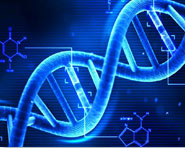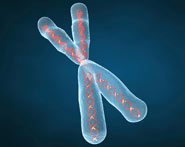


 النبات
النبات
 الحيوان
الحيوان
 الأحياء المجهرية
الأحياء المجهرية
 علم الأمراض
علم الأمراض
 التقانة الإحيائية
التقانة الإحيائية
 التقنية الحيوية المكروبية
التقنية الحيوية المكروبية
 التقنية الحياتية النانوية
التقنية الحياتية النانوية
 علم الأجنة
علم الأجنة
 الأحياء الجزيئي
الأحياء الجزيئي
 علم وظائف الأعضاء
علم وظائف الأعضاء
 الغدد
الغدد
 المضادات الحيوية
المضادات الحيوية| genetic testing (Breast cancer [BRCA] and ovarian cancer, Colon cancer, Cardiovascular disease, Tay–Sachs disease, Cystic fibrosis, Melanoma, Hemochromatosis, Thyroid cancer, Paternity [parentage analysis], Forensic genetic testing) |
|
|
|
Read More
Date: 2025-03-18
Date: 2025-03-26
Date: 2025-04-15
|
Type of test
Blood; miscellaneous
Normal findings
No genetic mutation
Test explanation and related physiology
Genetic testing is used to identify a predisposition to disease, to establish the presence of a disease, to establish or refute paternity, or to provide forensic evidence used in criminal investigations. Prenatal and newborn genetic tests are discussed on pp. 616 and 645.
Predictive tests for defective genes known to be associated with certain diseases are now commonly used in screening people who have certain phenotypes and family histories compatible with a genetic mutation. Genetic testing is done in addition to a family history (pedigree). As genetic testing becomes less expensive, the criteria for genetic testing is changing, as testing can be applied to a larger group of “at risk” individuals without increased costs. In this section, we discuss commonly performed genetic tests. There are many more familial diseases that can be predicted by genetic testing (see Table 1).
There are now direct-to-consumer (DTC) genetic testing kits that provide predictability about some diseases, allergies, body habitus, hair / eye color, and even paternity. There are potential risks and drawbacks to the use of DTC testing. Most DTC genetic tests look for only the major variants associated with a particular disease and do not test for minor harmful variants, causing a false sense of security for the patient who receives a “negative result.” Furthermore, interpretation of the genetic tests can be difficult and should be provided by a knowledgeable health care provider in order to avoid unneeded anxiety or false reassurance and to assist in making important decisions about preventative care. While all physician-ordered genetic testing is confidential, DTC genetic testing does not ensure privacy.
Table1. Genetic susceptibility syndromes
Breast cancer and ovarian cancer genetic testing
Inherited mutations in BRCA (BReast CAncer) genes indicate an increased susceptibility for development of breast cancer. The two genes in which mutations are most commonly seen are BRCA1 and BRCA2. The BRCA1 gene exists on chromosome 17, and BRCA2 is on chromosome 13. These genes encode tumor suppressor proteins. More than half of women who inherit mutations will develop breast cancer by the age of 50 years, compared with fewer than 2% of women without the genetic defect (Table 2). Also, see Table 3 for Interpretation of BRCA results.
The BRCA genes also confer an increased susceptibility for ovarian cancer. In the normal population, fewer than 2% of women develop ovarian cancer by age 70 years. Of women with mutations of the BRCA1 gene, 44% develop ovarian cancer by that age. Ovarian cancer is less commonly associated with the BRCA2 gene (20%). Furthermore, a woman with a BRCA mutation who has already had breast cancer has a 65% chance of developing a contralateral breast cancer in her lifetime (compared with < 15% of women without the genetic defect). A woman with breast cancer and a BRCA genetic defect has a 10 times greater risk of developing ovarian cancer as a second primary cancer compared with similar women without the mutated form of the gene.
These mutations have an autosomal dominant inheritance pattern, indicating that women who inherit just one genetic defect can develop the phenotypic cancers. Men with BRCA genetic mutations are at an increased risk for the development of breast, prostate, pancreas, and colon cancer. In addition, they can pass the mutation to their daughters. Because BRCA is an autosomal dominant gene, 50% of the children are at risk.
Table 2. Who should be tested for BRCA mutations?
Table3. Interpretation of genetic testing results
Colon cancer genetic testing
There are multiple forms of colon cancer strongly associated with family history. These genetic defects are inherited in an autosomal dominant fashion and are important for genome mismatch repair.
The most common form is familial adenomatous polyposis (FAP). The patient presents with over one hundred polyps in his or her colon—one or more of which may degenerate into cancer. FAP is caused by a genetic mutation in the 5q 21-22 (APC) gene on chromosome 5. These genes encode tumor suppression proteins.
Hereditary nonpolyposis colorectal cancer (HNPCC) syn drome is also known as Lynch syndrome. These patients are more difficult to recognize because they may have few polyps. HNPCC is associated most often with mutations (defective DNA mismatch repair) of MLH1, MLH2, and MSH6. HNPCC is associated with several other cancers (endometrial, gastric, and ovarian).
Tay–Sachs disease genetic testing
Tay–Sachs disease is a GM2 gangliosidosis characterized by the onset of severe mental and developmental retardation in the first few months of life. Affected children become totally debilitated by 2 to 5 years of age and die by ages 5 to 8 years. Another form of the same disease is late-onset Tay–Sachs or chronic GM2, also known as gangliosidosis. The basic defect in affected patients is a mutation in the hexosaminidase A gene, which is on chromosome 15. This gene is responsible for the synthesis of hexosaminidase (HEX), an enzyme that normally breaks down a fatty substance called GM2 gangliosides. Ashkenazi (Eastern European) Jews and non-Jewish French Canadians, particularly those in the Cajun population in Louisiana, are affected most. This gene is inherited as an autosomal recessive gene. Carriers have one affected gene. Affected individuals have both defective genes. A carrier couple has a 25% chance of having a child affected with the disease.
At present, there is no treatment for the disease; it is important to identify carriers so that reproductive counseling can be provided. HEX A protein testing (p. 503) has been extremely effective for identification of carriers and affected individuals. Both the test for the protein and that for the gene mutation are performed on a blood sample or on chorionic villus samples obtained during amniocentesis (p. 45).
Cystic fibrosis genetic testing
Cystic fibrosis (CF) is caused by a mutation in the cystic fibrosis transmembrane conductance regulator (CFTR) gene located on chromosome 7. A mutation in this gene alters the cell’s ability to regulate sodium, postassium, and chloride transport.
There are more than 1000 mutations and 200 polymorphisms of the CFTR gene. As a result, many mutations are without recognized effects on CFTR protein. Also, some CF mutations are associated with milder disease phenotypes and normal or borderline CFTR protein concentration. Gene mutation analysis is utilized for carrier identification, prenatal diagnosis in at-risk pregnancies, and newborn screening programs for CF.
CF is an autosomal recessive disease. A carrier has one mutated CFTR gene. The person affected by CF has mutations on both copies of CFTR. Genetic testing is now used to identify both carriers of CF and neonates with the disease, as well as to detect fetal disease during pregnancy. The sweat test (p. 846) is a more accurate method to diagnose the disease in affected children. The use of genetic testing for CF is often limited to those with a family history of CF, partners of CF patients, and pregnant couples with a family history of CF. Genetic testing can be performed on blood samples or on samples taken during chorionic villus sampling (CVS, p. 243) or during amniocentesis (p. 45).
Melanoma genetic testing
Recent progress in the genetics of cutaneous melanoma has led to the identification of two melanoma susceptibility genes:
• The tumor suppressor gene CDKN2A encoding the p16 protein on chromosome 9 p21 G • The CDK4 gene on chromosome 12 q13
The p16 genetic mutation is by far the most common form of hereditary melanoma. Characteristics of familial melanoma include frequent multiple primary melanomas, early age of onset of first melanoma, and frequently the presence of atypical or dysplastic nevi (moles). Family members with the following characteristics may consider testing for p16 genetic mutations:
• Multiple diagnoses of primary melanoma
• Two or more family members with melanoma
• Melanoma and pancreatic cancer
• Melanoma and a personal or family history of multiple atypical nevi
• Relatives of a patient with a p16 genetic mutation
The average age at diagnosis is 35 years for those with a mutation in p16 versus 57 years in the general population. P16 carriers also have an increased risk for pancreatic cancer.
Hemochromatosis genetic testing
The diagnosis of hemochromatosis is traditionally made by using serum iron studies. When hereditary hemochromatosis (HH) is suspected, mutation analysis of the hemochromatosis associated HFE genes (C282Y and H63D) is done. HH is an iron overload disorder that is considered to be the most common inherited disease in whites; it affects 1 in 500 individuals. Increased intestinal iron absorption and intracellular iron accumulation lead to progressive damage of the liver, heart, pancreas, joints, reproductive organs, and endocrine glands. Without therapy, men may develop symptoms between 40 and 60 years of age and women after menopause.
Patients with symptoms and early biochemical signs of iron overload consistent with HH should be tested. Relatives of individuals with HH should also be studied. Serum iron markers are monitored at more frequent intervals if an HFE mutation is detected. Early initiation of phlebotomy therapy reduces the hemochromatosis-related symptoms and organ damage.
Thyroid cancer genetic testing
Genetic testing for RET germline mutations has shown 100% sensitivity and specificity for identifying those at risk for devel oping inherited medullary thyroid cancer (multiple endocrine neoplasia [MEN] 2 A, MEN 2 B, or familial medullary thyroid carcinoma [FMTC]).
Use of the genetic assay allows earlier and more definitive identification and clinical management of those with a risk for FMTC. FMTC is surgically curable if detected before it has spread to regional lymph nodes. Thus there is an emphasis on early detection and intervention in families that are affected by MEN types 2 A and 2 B and FMTC.
Cardiac genetic testing
Mutations in sarcomeric genes cause early onset cardiac channelopathies and cardiomyopathies. These are rare but potentially lethal heart conditions that include long QT syndrome (LQTS), catecholaminergic polymorphic ventricular tachycardia (CPVT), hypertrophic cardiomyopathy (HCM), arrhythmogenic right ventricular cardiomyopathy, and dilated cardiomyopathy (DCM). Patients with a sarcomeric gene mutation are nearly three times more likely to have an adverse cardiac outcome. Identifying patients with these genetic mutations can help diagnose a patient’s disease, guide treatment options, and determine whether family members are at risk.
Paternity genetic testing
(parentage analysis) DNA testing is the most accurate form of testing to prove or exclude paternity when the identity of the biological father of a child is in doubt. By comparing DNA variants in the mother and child, it is possible to determine variants that the child inherited from the biological mother. Thus any remaining DNA variation must have come from the biological father. If the DNA from the tested man is found to contain these paternal characteristics, then the probability of paternity can be determined. Testing is more than 99% accurate. Testing is so reliable that it is admissible in court. Testing can be done on a mouth swab or blood. Results are usually available in 1 to 3 weeks.
Many parents are given misinformation at the time of twin births as to whether the twins are identical or fraternal. DNA samples from siblings can be analyzed to indicate whether twins are identical or fraternal with an accuracy of greater than 99%.
There are times, particularly in circumstances of rape, when early pregnancy paternity identification is desired. Noninvasive prenatal paternity testing can now be performed accurately by extracting and amplifying fetal chromosome alleles from maternal blood.
Forensic genetic testing
Forensic DNA testing is used with increasing frequency in today’s courtrooms because of its accuracy. Furthermore, DNA testing can be so conclusive that it often motivates plea bargaining and thereby reduces court time. It can quickly establish guilt or innocence beyond a reasonable doubt. Because DNA does not change and deteriorates very slowly even after death, testing can be performed on any body part, cadaver, or live person.
Specimens considered adequate for DNA testing include blood, teeth, semen, saliva, bone, nails, skin scrapings, and hair.
Contraindications
• Patients who are not emotionally able to deal with the results
Procedure and patient care
Before
- Explain the procedure to the patient.
- Tell the patient that no fasting is required.
-Tell the patient the time it will take to have the results back.
- Inform the patient of the high costs of genetic testing and that it may not be covered by all medical insurance plans.
During
• Obtain the specimen in a manner provided by the specialized testing laboratory.
- Blood: A venous blood sample is collected in a lavender top tube. Cord blood can be used for infants.
- Buccal swab: A cotton swab is placed between the lower cheek and gums. It is twisted and then placed on a special paper or in a special container. Usually two to four swabs are requested.
- Amniotic fluid: At least 20 mL of fluid is preferred.
- CVS: 10 mg of cleaned villi as prescribed by the laboratory.
- Product of conception: 10 mg of placental tissue are pre served in a sterile medium.
- Other body parts: As much tissue as is available is tested.
After
• Apply pressure or a dressing to the venipuncture site.
• Make sure that the patient has an appointment scheduled for obtaining the results.
• Ensure counseling after results are obtained.
Abnormal findings
Genetic carrier state
Affected state



|
|
|
|
مقاومة الأنسولين.. أعراض خفية ومضاعفات خطيرة
|
|
|
|
|
|
|
أمل جديد في علاج ألزهايمر.. اكتشاف إنزيم جديد يساهم في التدهور المعرفي ؟
|
|
|
|
|
|
|
العتبة العباسية المقدسة تنظّم دورةً حول آليّات الذكاء الاصطناعي لملاكاتها
|
|
|